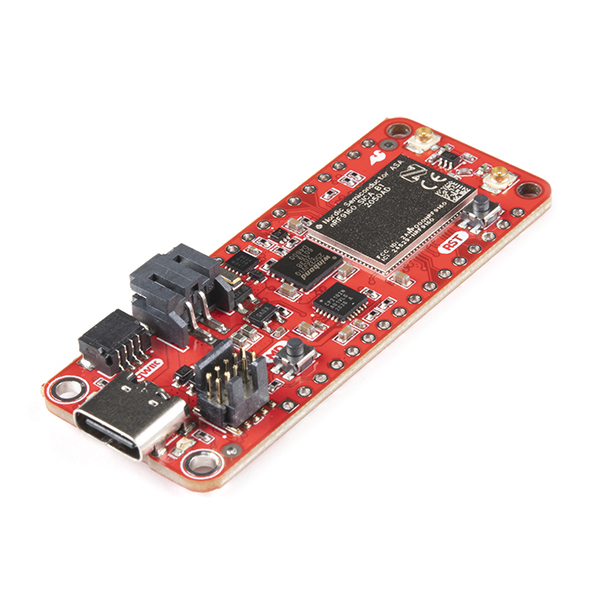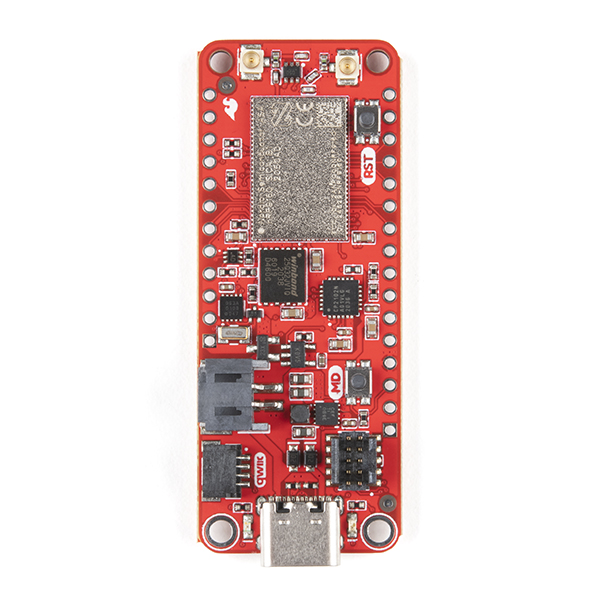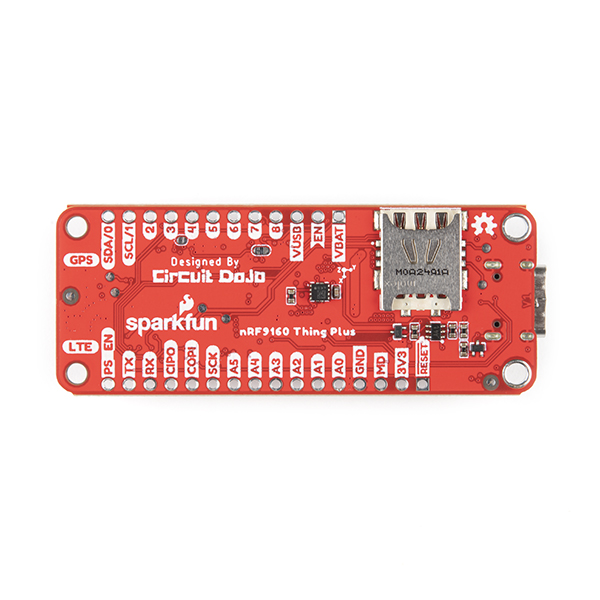SparkFun Thing Plus - nRF9160
SparkFun has teamed up with CircuitDojo to bring you the SparkFun nRF9160 Thing Plus, featuring the powerful Nordic nRF9160 microcontroller in a Feather-compatible footprint. This little chip is capable of both CAT M1 LTE and NB-IoT cellular communication and is designed to work with Zephyr, the go-to RTOS for embedded development. To make the Thing Plus even easier to use, this board utilizes our handy Qwiic Connect System which means no soldering or shields are required to connect it to the rest of your system!
Not only can you take advantage of Nordic’s advanced power states, but you can also put the device into a low power standby state. Laboratory measurements are putting that mode at about 2µA of current. 2µA! It also features a 3.3V Buck-Boost which helps get every mWh from your batteries as possible.
No batteries? No problem! Power your nRF9160 Thing Plus externally with a USB-C cable. Keep it on at all times for high availability scenarios.
Want to persist data? The nRF9160 Thing Plus has a 4MB external flash for storing data while offline. Using external flash with a filesystem like LitteFS and you’ll have a project to recon with!
The SparkFun Qwiic Connect System is an ecosystem of I2C sensors, actuators, shields and cables that make prototyping faster and less prone to error. All Qwiic-enabled boards use a common 1mm pitch, 4-pin JST connector. This reduces the amount of required PCB space, and polarized connections mean you can’t hook it up wrong.
- 1x SparkFun Thing Plus - nRF9160
- 1x Hologram SIM Card
- Nordic nRF9160 Microcontroller with ARM Cortex M33
- 1MB Flash
- 256kB RAM
- ARM® TrustZone®
- ARM® Cryptocell 310
- Up to 4x SPI, I2C and UART with Easy DMA
- I2S w/ EasyDMA
- 4x PWM with EasyDMA
- 12bit SADC with EasyDMA
- 2x RTC
- PPI (Programmable peripheral interconnect) interface
- Radio
- Transceiver and baseband
- 3GPP LTE release 13 Category M1 and NB1 compliant
- 3GPP release 14 NB2 compliant
- GPS receiver (GPS L1 C/A supported) - Active antenna only.
- RF Transceiver for global coverage supporting bands:
- Cat-M1: B1, B2, B3, B4, B5, B8, B12, B13, B14, B17, B18, B19, B20, B25, B26, B28, B66
- Cat-NB1/NB2: B1, B2, B3, B4, B5, B8, B12, B13, B17, B18, B20, B25, B26, B28, B66
- Supports 4FF Nano SIM
- USB-C connection for USB-to-Serial and DFU
- Pre-programmed MCUBoot bootloader
- External NOR Flash by Winbond
- 4MB of space
- Max bus speed of 133MHz
- Standard SPI
- Power supply
- 3.3V Buck/Boost up to 0.9A of current draw
- Operating range 2.8 to 5.5V
- External LiPoly battery connection (JST SPH type)
- Charge rate set to 300mA with LED indication
- Programmer
- Capable of interfacing with J-Link and CMSIS-DAP based programmers
- Low Power RTC on board for time keeping and as a low power wakeup source.
- User I/O
- Standard feather form factor GPIOs (0.1" pitch)
- 2x buttons (1 Reset, 1 General Purpose)
- 1x Blue LED connected to D7
- Antenna connections:
- 1x U.FL for LTE with matching network
- 1x U.FL for active GPS antennas
- Feather form factor
- 58.42mm x 22.86mm (2.3" x 0.9")
SparkFun Thing Plus - nRF9160 Product Help and Resources
nRF9160 Thing Plus Hookup Guide
May 6, 2021
Getting started with the nRF9160 from Circuit Dojo and SparkFun!
Core Skill: Programming
If a board needs code or communicates somehow, you're going to need to know how to program or interface with it. The programming skill is all about communication and code.
Skill Level: Competent - The toolchain for programming is a bit more complex and will examples may not be explicitly provided for you. You will be required to have a fundamental knowledge of programming and be required to provide your own code. You may need to modify existing libraries or code to work with your specific hardware. Sensor and hardware interfaces will be SPI or I2C.
See all skill levels
Core Skill: Electrical Prototyping
If it requires power, you need to know how much, what all the pins do, and how to hook it up. You may need to reference datasheets, schematics, and know the ins and outs of electronics.
Skill Level: Rookie - You may be required to know a bit more about the component, such as orientation, or how to hook it up, in addition to power requirements. You will need to understand polarized components.
See all skill levels
Comments
Looking for answers to technical questions?
We welcome your comments and suggestions below. However, if you are looking for solutions to technical questions please see our Technical Assistance page.
Customer Reviews
No reviews yet.





This is an awesome board! However as Rob mentioned, it is a bit expensive and more complex. It would be SuperCool if Sparkfun made a cellular IoT board much like the Particle Boron. Simpler and less expensive and also using the Feather format which is terrific.
I like that there is a buck-boost converter on this board. I would really like to see buck or buck-boost converters on future boards so that there is a little bit of added efficiency.